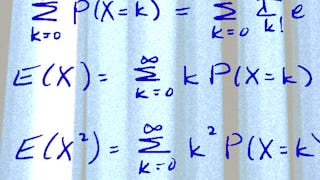This course introduces the theoretical, philosophical, and mathematical foundations of Bayesian Statistical inference. Students will learn to apply this foundational knowledge to real-world data science problems. Topics include the use and interpretations of probability theory in Bayesian inference; Bayes’ theorem for statistical parameters; conjugate, improper, and objective priors distributions; data science applications of Bayesian inference; and ethical implications of Bayesian statistics.



Expérience recommandée
Ce que vous apprendrez
Implement Bayesian inference to solve real-world statistics and data science problems.
Articulate the logic of Bayesian inference and compare and contrast it with frequentist inference.
Utilize conjugate, improper, and objective priors to find posterior distributions.
Compétences que vous acquerrez
- Catégorie : Analytical Skills
- Catégorie : Data Science
- Catégorie : Predictive Analytics
- Catégorie : Bayesian Statistics
- Catégorie : Probability
- Catégorie : Statistical Inference
- Catégorie : Data Ethics
- Catégorie : Statistical Modeling
- Catégorie : Probability Distribution
- Catégorie : Statistical Methods
- Catégorie : Regression Analysis
Détails à connaître

Ajouter à votre profil LinkedIn
mai 2025
5 devoirs
Découvrez comment les employés des entreprises prestigieuses maîtrisent des compétences recherchées

Il y a 5 modules dans ce cours
This module introduces learners to Bayesian statistics by comparing Bayesian and frequentist methods. The introduction is motivated by an example that illustrates how different assumptions about data collection - specifically, stopping rules - can result in different conclusions when using frequentist methods. Bayesian methods, on the other hand, yield the same conclusion regardless of stopping rules. This example illuminates a key philosophical difference between frequentist and Bayesian methods.
Inclus
8 vidéos4 lectures1 devoir3 devoirs de programmation1 sujet de discussion2 laboratoires non notés
This module introduces learners to Bayesian inference through an example using discrete data. The example demonstrates how the posterior distribution is calculated and how uncertainty is quantified in Bayesian statistics. The module also describes methods for summarizing the posterior distribution and introduces learners to the posterior predictive distribution through use of the Monte Carlo simulation. Monte Carlo simulations will be important for advanced computational Bayesian methods.
Inclus
6 vidéos1 devoir1 devoir de programmation2 laboratoires non notés
This module introduces learners to methods for conducting Bayesian inference when the likelihood and prior distributions come from a convenient family of distributions, called conjugate families. Conjugate families are a class of prior distributions for which the posterior distribution is in the same class. The module covers the beta-binomial, normal-normal and inverse gamma-normal conjugate families and includes examples of their application to find posterior distributions in R.
Inclus
7 vidéos1 lecture1 devoir1 devoir de programmation2 laboratoires non notés
This module motivates, defines, and utilizes improper and so-called "objective" prior distributions in Bayesian statistical inference.
Inclus
7 vidéos1 lecture1 devoir1 devoir de programmation2 laboratoires non notés
In this module, learners will be introduced to Bayesian inference involving more than one unknown parameter. Multiparameter problems are motivated with a simple example: a conjugate prior, two-parameter model involving normally distributed data. From there, we learn to solve more complex problems, including Bayesian linear regression and variance-covariance matrix estimation.
Inclus
9 vidéos1 lecture1 devoir1 devoir de programmation3 laboratoires non notés
Obtenez un certificat professionnel
Ajoutez ce titre à votre profil LinkedIn, à votre curriculum vitae ou à votre CV. Partagez-le sur les médias sociaux et dans votre évaluation des performances.
Instructeur

Offert par
En savoir plus sur Probability and Statistics
 Statut : Essai gratuit
Statut : Essai gratuitUniversity of Colorado Boulder
 Statut : Essai gratuit
Statut : Essai gratuitUniversity of Colorado Boulder
 Statut : Essai gratuit
Statut : Essai gratuitUniversity of Colorado Boulder

Duke University
Pour quelles raisons les étudiants sur Coursera nous choisissent-ils pour leur carrière ?





Ouvrez de nouvelles portes avec Coursera Plus
Accès illimité à 10,000+ cours de niveau international, projets pratiques et programmes de certification prêts à l'emploi - tous inclus dans votre abonnement.
Faites progresser votre carrière avec un diplôme en ligne
Obtenez un diplôme auprès d’universités de renommée mondiale - 100 % en ligne
Rejoignez plus de 3 400 entreprises mondiales qui ont choisi Coursera pour les affaires
Améliorez les compétences de vos employés pour exceller dans l’économie numérique
Foire Aux Questions
Access to lectures and assignments depends on your type of enrollment. If you take a course in audit mode, you will be able to see most course materials for free. To access graded assignments and to earn a Certificate, you will need to purchase the Certificate experience, during or after your audit. If you don't see the audit option:
The course may not offer an audit option. You can try a Free Trial instead, or apply for Financial Aid.
The course may offer 'Full Course, No Certificate' instead. This option lets you see all course materials, submit required assessments, and get a final grade. This also means that you will not be able to purchase a Certificate experience.
When you enroll in the course, you get access to all of the courses in the Specialization, and you earn a certificate when you complete the work. Your electronic Certificate will be added to your Accomplishments page - from there, you can print your Certificate or add it to your LinkedIn profile. If you only want to read and view the course content, you can audit the course for free.
If you subscribed, you get a 7-day free trial during which you can cancel at no penalty. After that, we don’t give refunds, but you can cancel your subscription at any time. See our full refund policy.
Plus de questions
Aide financière disponible,


